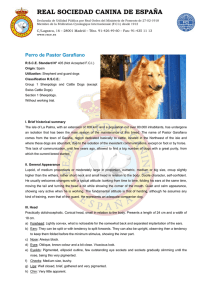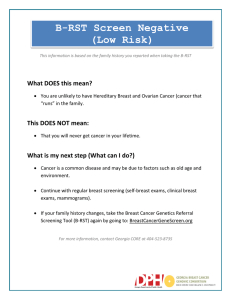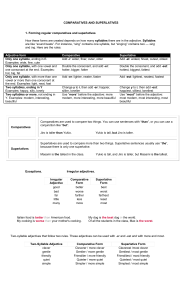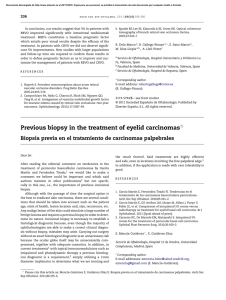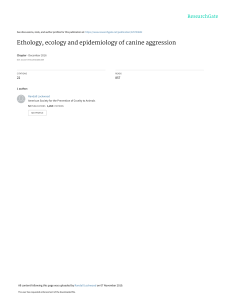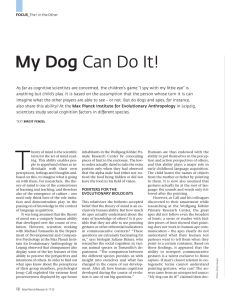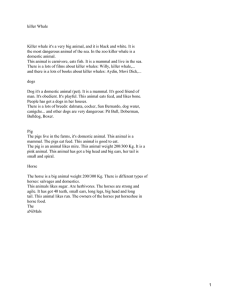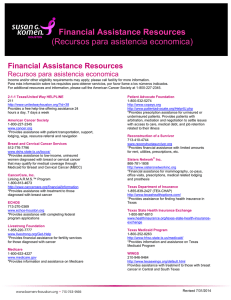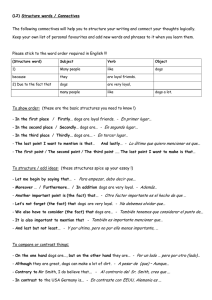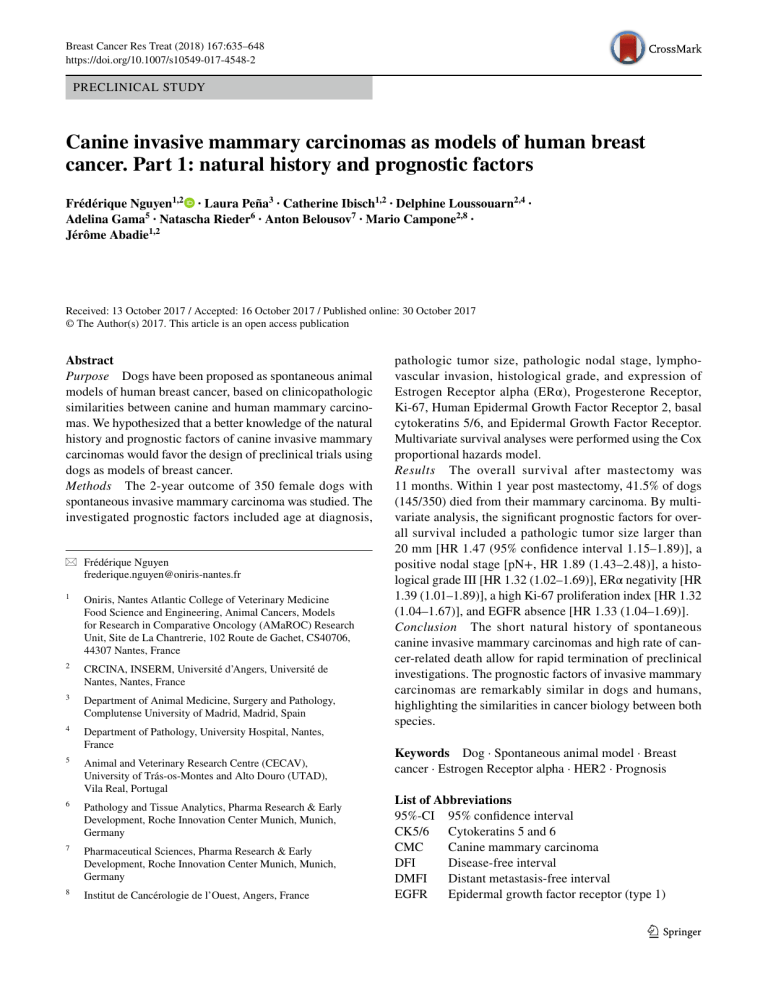
Breast Cancer Res Treat (2018) 167:635–648 https://doi.org/10.1007/s10549-017-4548-2 PRECLINICAL STUDY Canine invasive mammary carcinomas as models of human breast cancer. Part 1: natural history and prognostic factors Frédérique Nguyen1,2 · Laura Peña3 · Catherine Ibisch1,2 · Delphine Loussouarn2,4 · Adelina Gama5 · Natascha Rieder6 · Anton Belousov7 · Mario Campone2,8 · Jérôme Abadie1,2 Received: 13 October 2017 / Accepted: 16 October 2017 / Published online: 30 October 2017 © The Author(s) 2017. This article is an open access publication Abstract Purpose Dogs have been proposed as spontaneous animal models of human breast cancer, based on clinicopathologic similarities between canine and human mammary carcinomas. We hypothesized that a better knowledge of the natural history and prognostic factors of canine invasive mammary carcinomas would favor the design of preclinical trials using dogs as models of breast cancer. Methods The 2-year outcome of 350 female dogs with spontaneous invasive mammary carcinoma was studied. The investigated prognostic factors included age at diagnosis, * Frédérique Nguyen frederique.nguyen@oniris‑nantes.fr 1 Oniris, Nantes Atlantic College of Veterinary Medicine Food Science and Engineering, Animal Cancers, Models for Research in Comparative Oncology (AMaROC) Research Unit, Site de La Chantrerie, 102 Route de Gachet, CS40706, 44307 Nantes, France 2 CRCINA, INSERM, Université d’Angers, Université de Nantes, Nantes, France 3 Department of Animal Medicine, Surgery and Pathology, Complutense University of Madrid, Madrid, Spain 4 Department of Pathology, University Hospital, Nantes, France 5 Animal and Veterinary Research Centre (CECAV), University of Trás-os-Montes and Alto Douro (UTAD), Vila Real, Portugal 6 Pathology and Tissue Analytics, Pharma Research & Early Development, Roche Innovation Center Munich, Munich, Germany 7 Pharmaceutical Sciences, Pharma Research & Early Development, Roche Innovation Center Munich, Munich, Germany 8 Institut de Cancérologie de l’Ouest, Angers, France pathologic tumor size, pathologic nodal stage, lymphovascular invasion, histological grade, and expression of Estrogen Receptor alpha (ERα), Progesterone Receptor, Ki-67, Human Epidermal Growth Factor Receptor 2, basal cytokeratins 5/6, and Epidermal Growth Factor Receptor. Multivariate survival analyses were performed using the Cox proportional hazards model. Results The overall survival after mastectomy was 11 months. Within 1 year post mastectomy, 41.5% of dogs (145/350) died from their mammary carcinoma. By multivariate analysis, the significant prognostic factors for overall survival included a pathologic tumor size larger than 20 mm [HR 1.47 (95% confidence interval 1.15–1.89)], a positive nodal stage [pN+, HR 1.89 (1.43–2.48)], a histological grade III [HR 1.32 (1.02–1.69)], ERα negativity [HR 1.39 (1.01–1.89)], a high Ki-67 proliferation index [HR 1.32 (1.04–1.67)], and EGFR absence [HR 1.33 (1.04–1.69)]. Conclusion The short natural history of spontaneous canine invasive mammary carcinomas and high rate of cancer-related death allow for rapid termination of preclinical investigations. The prognostic factors of invasive mammary carcinomas are remarkably similar in dogs and humans, highlighting the similarities in cancer biology between both species. Keywords Dog · Spontaneous animal model · Breast cancer · Estrogen Receptor alpha · HER2 · Prognosis List of Abbreviations 95%-CI95% confidence interval CK5/6Cytokeratins 5 and 6 CMCCanine mammary carcinoma DFIDisease-free interval DMFIDistant metastasis-free interval EGFREpidermal growth factor receptor (type 1) 13 Vol.:(0123456789) 636 ERαEstrogen receptor alpha HER2Human epidermal growth factor receptor type 2 HESHematoxylin–eosin-saffron HRHazard ratio IHCImmunohistochemistry LRRLocoregional relapse LVILymphovascular invasion MDistant metastasis OSOverall survival PRProgesterone Receptor pTPathologic tumor size pNPathologic nodal stage SSSpecific survival Introduction Breast cancer represents the most prevalent cancer and the leading cause of cancer death in women worldwide [1]. Despite considerable progress in breast cancer management, prognosis in the metastatic setting remains poor. The 5-year specific survival after initial diagnosis was estimated 97% for stage I, 88% for stage II, 70% for stage III, and only 25% for stage IV breast cancer [2]. One of the current challenges is to define molecular tools and relevant models that can predict the response and potential resistance to therapies. The classic in vitro (tumor cell lines) and in vivo (xenografts) preclinical models have indeed limitations related to the difficulty to reproduce interactions with the microenvironment, the absent or incomplete metastatic pattern, and their inability to fully integrate the host immune response [3]. Spontaneous tumor models are thus of high interest, to study the pharmacokinetics of innovative therapeutics in vivo, their effect on tumor (pathologic response) and patient (metastasis, survival), and the interactions between tumor cells and their microenvironment. In this respect, canine spontaneous cancers seem particularly relevant to human oncology [4–6]. Although their prevalence decreases in regions where early preventive ovariectomy is routinely performed, canine mammary carcinomas (CMCs) remain the most common canine cancer, with an estimated annual incidence of 182 per 100,000 female dogs [7]. Recent publications describe the relevance of spontaneous CMCs as models of human breast cancer, because of their high incidence, similarities in relative age of onset, risk factors, biological behavior, and metastatic pattern [8–11]. However, the biological behavior of CMCs needs further evaluation. Few studies dealt with the natural history of CMCs, i.e., the outcome of dogs after mastectomy as single therapy [12–17]. The prognostic factors of CMCs were poorly described, usually in medium-sized cohorts (45–229 dogs), and mostly by univariate analyses [15–29], although multivariate analyses are available [14, 30–41]. Because adjuvant chemotherapy does 13 Breast Cancer Res Treat (2018) 167:635–648 not significantly improve survival in dogs with advanced invasive CMC [41], and because tamoxifen-based hormone therapy is associated with significant adverse effects [42], most dogs benefit only from mastectomy, sometimes associated with ovariohysterectomy [43]. This situation allows studies of the natural history of invasive CMCs, and the identification of prognostic factors without the confounding effects of adjuvant therapy. This also favors preclinical therapeutic trials of new anti-cancer drugs as first-line regimens, rather than in relapsed patients with advanced cancer. Here, we hypothesized that (1) knowledge of the natural history of CMCs would emphasize the aggressive and short course of the disease, and could be useful for the design of preclinical therapeutic trials in dogs with CMC, as translational models of human breast cancer; (2) knowledge of the prognostic factors of CMCs would highlight the biological similarities between spontaneous CMCs and breast cancers. The aims of this study were thus to describe the natural history of invasive CMCs, i.e., cancer progression and mortality rates, in the largest cohort collected so far (350 female dogs); to describe invasive CMCs using human pathological criteria including immunohistochemical markers; and to validate these criteria as prognostic factors able to predict patients’ outcome. In part 2 of this article, we evaluated the prognostic significance of the immunohistochemical classification of human breast cancer applied to dogs. Methods Patients and samples This retrospective study included 350 female dogs with invasive mammary carcinoma, but free from other cancer, initially diagnosed in two laboratories of veterinary histopathology (Laboratoire d’Histopathologie Animale, Oniris, Nantes, and Laboratoire d’Anatomie Pathologique Vétérinaire d’Amboise, France) between 2007 and 2010. The owners’ written consent and approval from the Oniris College of Veterinary Medicine local Animal Welfare Committee were obtained prior to inclusion. Dogs were eligible for inclusion when a histological diagnosis of invasive mammary carcinoma was established and confirmed by an absent layer of p63-positive myoepithelial cells (anti-p63 antibody, clone ab111449, Abcam) by immunohistochemistry (IHC) that differentiates invasive from in situ mammary carcinomas [44, 45]. All dogs were treated surgically by their veterinarian, and none of them received any additional treatment before and/or after mastectomy. Age, breed, spay status, parity, contraception, prior benign mammary lesions, medical history, and outcome were obtained through written questionnaires or telephone interviews with referring veterinarians and owners. All 350 Breast Cancer Res Treat (2018) 167:635–648 dogs were followed for at least 48 months with particular emphasis on the occurrence of locoregional relapse (time between mastectomy and the earliest local recurrence on the same mammary gland, new primary mammary tumor, or lymph node metastasis), distant metastasis-free interval (time from mastectomy to first evidence of distant metastases by medical imaging), and disease-free interval (interval from mastectomy to the first local recurrence, new primary tumor, lymph node metastasis, and/or distant metastasis). Overall survival was defined as the time between mastectomy and death from any cause. Specific survival was defined as the time between mastectomy and death attributable to the mammary carcinoma. Pathological evaluation Histological examination was performed on 3-μm-thick hematoxylin–eosin-saffron (HES) stained sections. The 350 tumors were classified according to the human breast cancer classification adapted to dogs (World Health Organization classification system) [46, 47], and graded according to the criteria of Elston and Ellis [48] adapted to canine mammary carcinomas [38]. The pathologic tumor size (pT, measured on histological slides), lymphovascular invasion (LVI), dermal infiltration, cutaneous ulceration, muscle invasion, margin status, and central necrosis were recorded for each case. Peritumoral lymphohistiocytic inflammation was considered positive when moderate to severe. In case of multicentric CMC, the largest tumor and/or tumor of highest histological grade was considered for prognostic purposes. The methods used for IHC were detailed previously [35]. Briefly, automated IHC (Benchmark XT Ventana, Roche Diagnostics) was performed on 3-μm-thick serial sections using the following antibodies: monoclonal mouse antihuman Estrogen Receptor alpha (ERα, clone C311, Santa Cruz, dilution 1:50), monoclonal rabbit anti-human Progesterone Receptor (PR, clone 1E2, Roche Diagnostics, prediluted), monoclonal rabbit anti-Human Epidermal Growth Factor Receptor Type 2 (HER2, clone 4B5, Roche Diagnostics, prediluted), polyclonal rabbit anti-HER2 (Dako A0485, dilution 1:400), monoclonal mouse anti-human Ki-67 (clone MIB1, Dako, dilution 1:50), monoclonal mouse anti-human Cytokeratins 5/6 (CK5/6, clone D5/16B4, Dako, dilution 1:50), and monoclonal mouse anti-Epidermal Growth Factor Receptor Type 1 (EGFR, clone 31G7, Invitrogen, dilution 1:20). ERα, PR, and Ki-67 were assessed based on the number of positive nuclei among > 500 neoplastic cells (manual image analysis, Image J software, National Institute of Health, Bethesda, Maryland, USA), and considered positive at threshold ≥ 10% for ERα and PR [45, 49], CK5/6, and EGFR [50]. The > 33.3% threshold for Ki-67 was evaluated by the receiver-operator-characteristic curve calculated for 637 2-year cancer-specific mortality. HER2 was scored 0 for no staining at all or incomplete, faint/barely perceptible membrane staining in ≤ 10% of tumor cells; 1 + for incomplete and faint/barely perceptible membrane staining in > 10% of tumor cells; 2 + for circumferential and incomplete and/ or weak/moderate membrane staining in > 10% of tumor cells; or incomplete and circumferential membrane staining that is intense but within ≤ 10% of tumor cells; and 3 + for circumferential, complete, and intense membrane staining in > 10% of tumor cells. Carcinomas were considered HER2 positive only for a 3 + IHC score [45, 51]. Negative controls were included in each IHC run, and consisted in replacing the primary antibody with normal mouse or rabbit serum (prediluted reagents, Roche Diagnostics). The positive controls were mostly internal (epidermis and hair follicles for Ki-67, CK5/6, and EGFR; nonneoplastic mammary gland surrounding the carcinoma for ERα and PR; sebaceous glands for ERα). For HER2, the pathway HER2 4-in-1 control slides (Roche Diagnostics) were chosen to assess the quality of staining for each HER2 score (0, 1 + , 2 + , 3 +). Four veterinary pathologists (JA, FN, LP, AG) and 1 medical pathologist (DL) examined the HES and IHC slides blindly (i.e., without any information on the dog or on the other pathologists’ interpretation). In case of discrepancy between evaluators, cases were collectively reviewed in order to achieve a consensual diagnosis, grade, and immunohistochemical scoring. Statistical analyses The ­MedCalc® statistical software (Ostend, Belgium) was used. Continuous variables are expressed as median, [range], mean ± standard deviation. Correlations between categorical variables were analyzed using the Pearson Chi-square test. The Kaplan–Meier method and log-rank tests were used for univariate survival analyses, and Cox proportional hazards models for multivariate survival analyses, whose results are reported using the Hazard Ratio (HR), its confidence interval (95%-CI), and the p value of each covariate. For all statistical tests, a p value < 0.05 was considered significant. Results Clinicopathologic features of invasive canine mammary carcinomas (CMCs) The cohort comprises 350 female dogs with invasive CMC, including 253 (72.3%) intact and 97 (27.7%) spayed female dogs. The main characteristics of patients and CMCs are given in Table 1. The mean age at diagnosis was 11.0 ± 2.1 years [range (3.6–16.3), median 11.0 years]. 13 638 Breast Cancer Res Treat (2018) 167:635–648 Table 1 Characteristics of dogs and their invasive mammary carcinoma at diagnosis Age (years) (n = 349)a < 11.7 years ≥ 11.7 years Spay status (n = 350) Intact females Neutered females Multicentricity (n = 350) Single carcinoma Multicentric carcinoma Pathologic tumor size (n = 350) pT < 20 mm pT ≥ 20 mm Pathologic nodal stage (n = 350) pN0 pNX pN+ Lymphovascular invasion (n = 350) LVI+ LVI– Histological grade (n = 350) I II III Histological type (n = 350) Invasive mammary carcinoma Simple tubulopapillary Simple solid Complex Anaplastic Squamous cell Inflammatory Surgical margins (n = 350) Positive margins Negative margins Peritumoral inflammation (n = 350) Yes (moderate to severe) No (absent to mild) ERα (n = 350) ER+ (≥ 10%) ER– (< 10%) PR (n = 350) PR+ (≥ 10%) PR– (< 10%) Ki-67 (n = 350) Ki-67 low (≤ 33.3%) Ki-67 high (> 33.3%) HER2 clone 4B5 (n = 350) 0 1+ 13 N % 229 120 65.6 34.4 253 97 72.3 27.7 295 55 84.3 15.7 141 209 40.3 59.7 39 236 75 11.1 67.4 21.4 171 179 48.9 51.1 19 106 225 5.4 30.3 64.3 350 176 103 31 21 14 5 100 50.3 29.4 8.9 6.0 4.0 1.4 158 192 45.1 54.9 168 182 48.0 52.0 57 293 16.3 83.7 40 310 11.4 88.6 162 188 46.3 53.7 246 76 70.3 21.7 Table 1 (continued) N 2+ 3+ HER2 polyclonal Dako (n = 350) 0 1+ 2+ 3+ CK5/6 (n = 350) CK5/6+ (≥ 10%) CK5/6– (< 10%) EGFR (n = 350) EGFR+ (≥ 10%) EGFR– (< 10%) a % 28 0 8.0 0 262 71 17 0 74.9 20.3 4.9 0 229 121 65.4 34.6 186 164 53.1 46.9 One case with missing data Fifty-seven breeds were represented. Mixed-breed dogs (n = 78, 22.3%) outnumbered Poodles (n = 50; 14.3%), German Shepherds (n = 25; 7.1%), Brittany and Labrador Retrievers (n = 19 each; 5.4%), and Yorkshire Terriers (n = 10; 2.9%). In 235 dogs (67.1%), the invasive carcinoma was the first mammary lesion detected, whereas 115 (32.9%) dogs had a history of previous non-malignant mammary lesions. Parity was unknown in 269 dogs (76.9%), and nulliparous females (n = 49; 14.0%) slightly outnumbered multiparous (n = 32; 9.1%) females. History of contraceptive use was reported in 20 (5.7%) dogs. Tumors involved the abdominal and inguinal mammary glands (M3 to M5) in 256 cases (73.1%), the thoracic mammary glands (M1–M2) in 50 (14.3%), both in 11 (3.1%), and location was unrecorded in 33 cases (9.4%). The most common surgical procedure was radical mastectomy (excision of the 5 mammary glands of the affected side) in 156 dogs (44.6%), followed by regional (M1–M3 or M3–M5) mastectomy in 112 cases (32.0%), and single mastectomy in 64 cases (18.3%). Information on the surgical procedure was missing in 18 dogs (5.1%). The mean pathologic tumor size was 18 ± 7 mm [median 18 mm, range (2–49), n = 227 dogs]; in the other cases, the pathologic tumor size could not be precisely determined due to larger size and/or positive margins. In 236 dogs (67.4%), the pathologic nodal stage was pNX due to absence of lymph node sampling for histopathology. Nodal stage pN+ (with metastasis of any size) was confirmed in 75 cases (21.4%). Six dogs (1.7%) had evidence of distant metastasis (M1) at diagnosis. All of the included cases correspond to invasive mammary carcinomas according to breast cancer classification. The predominant histological types were simple Breast Cancer Res Treat (2018) 167:635–648 tubulopapillary (n = 176; 50.3%), simple solid (n = 103; 29.4%), and complex carcinomas (malignant epithelial proliferation associated with benign myoepithelial proliferation, n = 31, 8.6%). The mean mitotic index was 41 ± 29 mitoses in 10 high-power fields [× 400, diameter of the field of view 0.55 mm; median 33, range (5–236)]. Regarding histopathological criteria of aggressiveness, dermal infiltration was present in 119 cases (34.0%), cutaneous ulceration in 50 cases (14.3%), abdominal or thoracic muscle infiltration in 65 cases (18.6%), peritumoral inflammation in 168 cases (48.0%), and central necrosis in 261 cases (74.6%). The mean ERα index was 6.3 ± 14.0% (0–87.6%); 58.0% of cases (n = 203) did not express ERα at all. The mean PR index was 5.4 ± 14.8% (0–92.0%); 65.4% (n = 229) of CMCs did not express PR at all. At positive threshold 10%, 57 CMCs (16.3%) were ER + and 40 (11.4%) were PR+ (Fig. 1). Two hundred and sixty-seven CMCs (76.3%) were ER – PR − , 26 (7.4%) were ER − PR + , 43 (12.3%) were ER + PR − , and only 14 (4.0%) were ER + PR + . The 639 mean Ki-67 index was 36.2 ± 17.4% [median 35.4%, range (1.3–94.6%)]. Both immunohistochemical protocols used to assess HER2 expression were highly correlated (p < 0.0001, Chisquare test). HER2 score 0 was predominant (70.3% of the cases with clone 4B5, 74.9% with polyclonal A0485), followed by HER2 score 1 + (Table 1). The cohort does not comprise any case with HER2 overexpression (score 3 +). Natural history and prognostic factors of canine invasive mammary carcinoma Locoregional relapse (LRR) The median time to LRR was 26.4 months; the LRR probability was 34% at 1 year, and 47% at 2 years post diagnosis (Fig. 2a). At the end of the follow-up period, 76 dogs (21.7%) had experienced tumor recurrence at the site of prior mastectomy, 56 dogs (16.0%) a new primary mammary tumor, and 18 dogs (5.1%) more than one locoregional event. Fig. 1 Immunohistochemical markers of canine invasive mammary carcinomas. Positivity to a Estrogen Receptor alpha (ERα, nuclear), b Progesterone Receptor (PR, nuclear), c the proliferation index Ki-67 (nuclear), d score 2 + for Human Epidermal Growth Factor Receptor type 2 (HER2, membranous), and positivity to e basal cytokeratins 5 and 6 (CK5/6, cytoplasmic), and f Epidermal Growth Factor Receptor type 1 (EGFR, membranous) in 6 different canine invasive mammary carcinomas. Indirect immunohistochemistry, initial magnification × 400, bar = 50 micrometers 13 640 Breast Cancer Res Treat (2018) 167:635–648 Fig. 2 Natural history of invasive mammary carcinoma in 350 female dogs. Kaplan–Meier curves for a Locoregional Relapse (LRR), b Distant Metastasis-Free Interval (DMFI), c Overall Survival (OS), and d Specific Survival (SS). The 95% confidence interval is shown for each survival curve By univariate analysis, 11 parameters were significantly associated with the LRR risk (Table 2), of which 4 remained as significant independent prognostic factors by multivariate analysis (p < 0.0001): the strongest predictor of locoregional relapse was ERα positivity (HR 0.48), followed by the pathological nodal stage pN + (HR 1.92), the presence of lymphovascular invasion, and positive margins (HR = 1.55 for each). analysis (p < 0.0001): the strongest was lymphovascular invasion (HR 2.66), followed by age at diagnosis (HR 2.16 for older dogs), multicentricity (HR 1.89), and the Ki-67 proliferation index (HR 1.0149). Distant Metastasis‑Free Interval (DMFI) The risk of distant metastasis was 17% at 1 year and 24% at 2 years post diagnosis (Fig. 2b), and was likely underestimated in this retrospective cohort, as the dogs’ owners may have declined complete staging, for financial reasons. By univariate analysis, six parameters were significantly associated with DMFI (Table 3), of which four remained as significant independent prognostic factors by multivariate 13 Disease‑free interval (DFI) The median DFI was 34.4 months. Cancer progression (locoregional recurrence and/or distant metastasis) was recorded in 34% of dogs at 1 year post diagnosis, and 45% at 2 years. By univariate analysis, 13 parameters were significantly associated with DFI (Table 4), of which 4 were independent prognostic factors by multivariate analysis (p < 0.0001): the pathologic nodal stage pN + (HR 1.92), ERα negativity (HR 1.69), a high proliferation index (HR 1.59), and positive margins (HR 1.54). Breast Cancer Res Treat (2018) 167:635–648 641 Table 2 Prognostic factors for Locoregional Relapse of canine invasive mammary carcinomas by univariate and multivariate analyses Univariate analysis Breed Molossoid breeds British and Irish pointing dogs Japanese, Chinese and Pekingese Spaniels Continental Toy Spaniels Molossian Toy dogs Any other breed Histological type Anaplastic CMC Inflammatory CMC Any other type Lymphovascular invasion LVI− versus LVI+ Pathologic nodal stage pN+ versus pN0–pNX Margin status Positive versus negative margins Central necrosis Absent versus present Peritumoral inflammation No versus yes ERα ER+ versus ER− PR PR+ versus PR− Ki-67 Continuous (%) EGFR EGFR+ versus EGFR− HR 95%-CI p 2.26 4.61 8.22 11.56 16.40 1.00 1.10–4.64 1.74–12.20 1.11–61.09 1.52–87.73 2.17–123.95 Reference 0.0266 0.0022 0.0406 0.0185 0.0070 2.38 12.22 1.00 1.19–4.77 4.30–34.74 Reference 0.0148 < 0.0001 0.49 0.35–0.69 < 0.0001 2.31 1.46–3.67 < 0.0001 1.86 1.33–2.61 0.0001 1.46 0.99–2.18 0.0343 0.67 0.48–0.92 0.0105 0.49 0.33–0.73 0.0036 0.54 0.34–0.88 0.0460 1.0107 1.0017–1.0197 0.0227 0.72 0.52–0.99 0.0428 1.55 1.08–2.24 0.0181 1.92 1.30–2.84 0.0012 1.55 1.10–2.18 0.0135 0.48 0.29–0.79 0.0040 Multivariate analysis Lymphovascular invasion LVI+ versus LVI− Pathologic nodal stage pN+ versus pN0–pNX Margin status Positive versus negative margins ERα ER+ versus ER− Overall survival (OS) During the follow-up period, 310 dogs (88.6%) died (Fig. 2c). The median OS was 11.4 months (2 days–75 months). The mortality rate was 51.7% at 1 year and 72.0% at 2 years post diagnosis. Death was unrelated to cancer in 58 dogs (16.6%), from unknown causes in 65 dogs (18.6%), and attributable to the invasive CMC in 187 dogs (53.4%). By univariate analysis, 16 parameters were significantly associated with OS (Table 5), of which 6 were independent prognostic factors by multivariate analysis (p < 0.0001). The strongest prognostic factors were the pathologic nodal stage (pN + : HR 1.89) and pathologic tumor size (pT ≥ 20 mm: HR 1.47), followed by the histological grade, ERα positivity, the Ki-67 index, and EGFR expression (HR 1.32–1.39). 13 642 Breast Cancer Res Treat (2018) 167:635–648 Table 3 Prognostic factors for Distant Metastasis-Free Interval (DMFI) of dogs with invasive mammary carcinomas (n = 350) Univariate analysis Age at diagnosis ≤ 11.7 versus > 11.7 years Multicentricity Single versus multicentric Lymphovascular invasion LVI− versus LVI+ Pathologic nodal stage pN+ versus pN0–pNX Peritumoral inflammation No versus yes Ki-67 Continuous (%) HR 95%-CI p 0.44 0.25–0.75 0.0007 0.44 0.20–0.96 0.0047 0.33 0.20–0.56 <0.0001 1.86 0.92–3.75 0.0326 0.58 0.35–0.96 0.0281 1.0203 1.0068–1.0339 0.0045 2.16 1.29–3.62 0.0037 1.89 1.03–3.46 0.0404 2.66 1.56–4.53 0.0003 1.0149 1.0007–1.0293 0.0412 Multivariate analysis Age at diagnosis > 11.7 versus ≤ 11.7 years Multicentricity Multicentric versus single Lymphovascular invasion LVI+ versus LVI− Ki-67 Continuous (%) Specific survival The median time to death attributable to cancer was 19.5 months [2 days–56 months] (Fig. 2d). The cancerrelated death rate was 41.5% at 1 year and 54.1% at 2 years post diagnosis. By univariate analysis, 15 clinicopathologic parameters were significantly associated with cancer-related death (Table 6), of which six were independent prognostic factors by multivariate analysis (p < 0.0001). The most significant predictors of cancer-related death were those that define the stage of invasive CMCs: the pathologic tumor size (pT ≥ 20 mm: HR 1.41), pathologic nodal stage (pN + : HR = 1.82), and the presence of distant metastases at diagnosis (M1: HR 2.61). Peritumoral inflammation (HR 1.54), ERα negativity (HR 1.56), and a high Ki-67 proliferation index (HR 1.67) were also associated with cancer-related death, independently of the stage of the carcinoma at diagnosis. Discussion Dogs with invasive mammary carcinomas have been proposed as a useful resource for preclinical research in comparative oncology due to epidemioclinical, biological, and 13 pathological similarities with human breast cancer [8–11]. There was, however, a relative uncertainty of predictability of this spontaneous cancer as a translational model, as the natural history and prognostic factors have been described in relatively small cohorts [19–25, 27–41]. The present study is of particular interest because (1) mammary carcinomas in situ have been carefully excluded from analysis, using p63 immunohistochemistry when necessary, which is rarely, if ever, performed in veterinary studies, but of paramount importance in human breast oncology; (2) the cases were reviewed blindly by veterinary and medical pathologists, until consensus diagnoses were achieved, which permitted interpretation of canine samples using the criteria used for human breast cancer; (3) this is the largest cohort of CMCs described so far, which allowed for multivariate survival analyses with sufficient statistical power; (4) this study is one of the rare reports [14, 15, 17, 30, 37] of locoregional recurrence, distant metastasis-free interval, and specific survival in dogs with CMCs, as most previous studies focused on disease-free survival and overall survival only [18–21, 23–25, 28, 29, 31, 32, 35, 38, 39]. The epidemiological characteristics of CMCs in this cohort, although in agreement with some previous reports [20, 33], are characterized by an older age at diagnosis, lower rate of positivity to ERα and PR, and higher Ki-67 index than previous descriptions [19, 23, 27, 31, 37, 39]. Breast Cancer Res Treat (2018) 167:635–648 643 Table 4 Prognostic factors for Disease-Free Interval of dogs with invasive mammary carcinomas (n = 350) Univariate analysis Age at diagnosis Continuous (years) Breed British and Irish pointing dogs Continental Toy Spaniels Molossian Toy dogs Any other breed Multicentricity Single versus multicentric Histological type Anaplastic CMC Inflammatory CMC Any other type Histological grade I versus II–III Lymphovascular invasion LVI− versus LVI+ Pathologic nodal stage pN+ versus pN0–pNX Muscle invasion No versus yes Margin status Positive versus negative margins Peritumoral inflammation No versus yes ERα ER+ versus ER− Ki-67 Continuous (%) EGFR EGFR+ versus EGFR− HR 95%-CI p 1.1511 1.0624–1.2473 3.60 22.64 15.41 1.00 1.38–9.43 5.10–100.46 2.04–116.71 Reference 0.50 0.30–0.84 0.0007 2.11 6.81 1.00 1.01–4.38 1.63–28.54 Reference 0.0468 0.0090 0.36 0.15–0.89 0.0284 0.35 0.25–0.49 < 0.0001 2.20 1.37–3.51 < 0.0001 0.67 0.42–1.06 0.0482 1.63 1.15–2.30 0.0031 0.65 0.46–0.91 0.0093 0.57 0.38–0.85 0.0222 1.0164 1.0073–1.0256 0.0006 0.72 0.51–1.00 0.0473 1.54 1.09–2.16 0.0140 1.92 1.30–2.82 0.0011 0.59 0.36–0.97 0.0367 0.63 0.45–0.89 0.0096 0.0006 0.0094 < 0.0001 0.0084 Multivariate analysis Margin status Positive versus negative margins Pathologic nodal stage pN+ versus pN0–pNX ERα ER + versus ER− Ki-67 ≤ 33.3% versus > 33.3% These differences can be attributed at least in part to the systematic exclusion of mammary carcinomas in situ, which are diagnosed in younger dogs, and are more commonly ERα and PR positive compared to invasive CMCs (unpublished observations, manuscript in preparation), as described in human breast cancer [52]. Another particularity of this cohort is the absence of any HER2-positive CMC, as previously reported [53]. However, HER2-positive CMCs have been previously described by immunohistochemistry, with the polyclonal A0485 antibody [18, 26, 54–58] or the CB11 clone [59]. In this study, the external positive controls (cytospins of breast carcinoma cell 13 644 Breast Cancer Res Treat (2018) 167:635–648 Table 5 Prognostic factors for Overall Survival of dogs with invasive mammary carcinomas (n = 350) Univariate analysis HR 95%-CI p 1.1508 1.0898–1.2152 0.73 0.57–0.93 0.0106 0.57 0.40–0.82 0.0001 Age at diagnosis Continuous (years) < 0.0001 History of contraception No versus yes/unknown Multicentricity Single versus multicentric Histological type Anaplastic CMC 3.45 2.18–5.46 < 0.0001 Inflammatory CMC 11.56 4.66–28.67 < 0.0001 Any other type 1.00 reference Histological grade I versus III 0.36 0.20–0.64 0.0006 II versus III 0.71 0.55–0.91 0.0066 Pathologic tumor size < 1 cm versus ≥ 2 cm 0.49 0.30–0.81 0.0054 1 cm ≤ pT < 2 cm versus ≥ 2 cm 0.65 0.51–0.83 0.0006 0.42 0.34–0.54 < 0.0001 Lymphovascular invasion LVI– versus LVI+ Pathologic nodal stage pN0 versus pNX 0.60 0.41–0.88 0.0091 pN+ versus pNX 1.80 1.38–2.36 < 0.0001 0.77 0.60–0.98 0.0276 0.66 0.48–0.91 0.0029 1.99 1.57–2.52 < 0.0001 0.68 0.54–0.85 0.0005 0.69 0.53–0.91 0.0169 0.65 0.52–0.81 0.0001 0.78 0.62–0.99 0.0376 0.76 0.58–0.98 0.0217 0.68 0.53–0.87 0.0026 1.89 1.43–2.48 < 0.0001 0.76 0.59–0.98 0.0328 0.72 0.53–0.99 0.0436 0.76 0.60–0.96 0.0228 1.33 1.04–1.69 0.0239 Dermal invasion No versus yes Muscle invasion No versus yes Margin status Positive versus negative margins Peritumoral inflammation No versus yes ERα ER+ versus ER− Ki-67 ≤ 33.3% versus > 33.3% CK5/6 CK5/6+ versus CK5/6− EGFR EGFR > 0 versus EGFR absent Multivariate analysis Pathologic tumor size pT < 20 mm versus pT ≥ 20 mm Pathologic nodal stage pN+ versus pN0–pNX Histological grade I–II versus III ERα ER+ versus ER− Ki-67 ≤ 33.3% versus > 33.3% EGFR EGFR absent versus EGFR > 0 13 Breast Cancer Res Treat (2018) 167:635–648 645 Table 6 Prognostic factors for Cancer-Specific Survival of dogs with invasive mammary carcinomas (n = 350) Univariate analysis Age at diagnosis Continuous (years) Breed group Mixed-breed British and Irish pointing dogs Continental Toy Spaniels Any other breed Distant metastasis M1 versus M0–MX Multicentricity Single versus multicentric Histological type Anaplastic CMC Inflammatory CMC Any other type Histological grade I versus III II versus III Pathologic tumor size < 1 cm versus ≥ 2 cm 1 cm ≤ pT < 2 cm versus ≥ 2 cm Lymphovascular invasion LVI− versus LVI+ Pathologic nodal stage pN0 versus pNX pN + versus pNX Central necrosis No versus Yes Dermal invasion No versus Yes Margin status Positive versus negative margins Peritumoral inflammation No versus yes ERα ER + versus ER− Ki-67 Continuous (%) HR 95%-CI p 1.1423 1.0652–1.2249 1.98 3.40 24.39 1.00 1.09–3.62 1.42–8.17 5.62–105.81 Reference 3.19 0.77–13.18 0.0031 0.50 0.32–0.78 0.0001 3.29 14.35 1.00 1.87–5.78 5.71–36.07 Reference 0.41 0.63 0.20–0.84 0.45–0.87 0.0151 0.0054 0.46 0.70 0.23–0.90 0.51–0.95 0.0251 0.0242 0.31 0.23–0.42 < 0.0001 0.53 2.13 0.30–0.92 1.54–2.94 0.0242 < 0.0001 1.38 0.98–1.96 0.0444 0.74 0.54–1.00 0.0427 1.93 1.43–2.60 < 0.0001 0.59 0.44–0.79 0.0003 0.61 0.43–0.88 0.0209 1.0179 1.0102–1.0257 < 0.0001 0.71 0.52–0.95 0.0232 1.82 1.30–2.54 0.0005 2.61 1.14–5.99 0.0245 1.54 1.14–2.07 0.0050 0.64 0.41–0.97 0.0380 0.0002 0.0264 0.0065 < 0.0001 < 0.0001 < 0.0001 Multivariate analysis Pathologic tumor size pT < 20 mm versus pT ≥ 20 mm Pathologic nodal stage pN+ versus pN0–pNX Distant metastasis M1 versus M0–MX Peritumoral inflammation Yes versus no ERα ER+ versus ER− 13 646 Breast Cancer Res Treat (2018) 167:635–648 Table 6 (continued) Multivariate analysis Ki–67 ≤ 33.3% versus > 33.3% 0.60 lines, representative of the HER2 scores 0–3 +) ensured that HER2 expression was neither underestimated nor overestimated on the canine slides, a precaution that was rarely taken in veterinary oncology [26, 54]. Of note, HER2 gene amplification was not previously found in CMCs [60], and thus the existence of HER2-positive mammary carcinomas in dogs is still uncertain [61, 62]. The natural history of invasive CMCs is much shorter in dogs (54% cancer-related death at 2 years post diagnosis in this study) than in human breast cancer [2], probably in relation to shorter life expectancy in dogs, and the lack of adjuvant therapy, a situation that favors the setting of preclinical trials in the canine species. The effects of a given compound on patient survival, including in first-line regimen, is expected to be evaluable in short delays in dogs with CMCs, an advantage already highlighted for other canine cancers [4, 5]. The prognostic factors of invasive CMCs, described here in the largest retrospective cohort described so far, include the pathologic tumor size, pathologic nodal stage, lymphovascular invasion, histological grade, and ERα positivity, which are all also strong prognostic factors in human breast cancer [63], confirming the similar biology of invasive mammary carcinomas in both species. Conclusions The results of the present study confirm that canine invasive mammary carcinomas have a short disease course, which is predictable with clinicopathologic criteria close to those of human oncology. In the second part of this article, we hypothesized that CMCs could be subdivided into luminal and triple-negative cases with different outcomes, as in human breast cancer. Acknowledgements The authors deeply acknowledge Dr. Chand Khanna (EthosDiscovery, EthosVeterinary Health) for his help in reviewing the manuscript. The authors thank Dr. Claire Hanzenne, Dr. Ingrid Bemelmans, Dr. Floriane Morio, and Dr. Clotilde de Brito, who helped in collecting the clinical and follow-up data. The authors also thank Dr. Laëtitia Jaillardon for her involvement in data analysis, the veterinary pathologists (Dr. Jean-Loïc Le Net, Dr. Virginie Théau, Dr. Pierre Lagourette, Dr. Olivier Albaric and Dr. Sophie Labrut) who performed the initial diagnoses of canine mammary carcinomas, as well as the technicians in histopathology (Mr. Bernard Fernandez, Mrs. Florence Lezin, and Mrs. Catherine Guéreaud) who made the slides. Finally, we thank the referring veterinarians and the owners of the dogs included in this study, who gave us the clinical and follow-up data. 13 0.44–0.81 0.0011 Funding This work was supported by the French National Cancer Institute (INCa, Institut National du Cancer) with a grant for translational research (INCa-DHOS 2010, Pr M. Campone) and one grant for PhD students on translational research (Grant N°201108; 2011); and by Roche Diagnostics GmbH, Germany, which provided financial and technical support for the immunohistochemical characterization of the carcinomas. Compliance with ethical standards Conflicts of interest The authors declare that they have no conflict of interest. Ethical approval All applicable international, national, and/or institutional guidelines for the care and use of animals were followed. The owners’ written consent and approval from the Oniris College of Veterinary Medicine local Animal Welfare Committee were obtained prior to inclusion of each canine mammary carcinoma in this retrospective observational study. Open Access This article is distributed under the terms of the Creative Commons Attribution 4.0 International License (http://creativecommons.org/licenses/by/4.0/), which permits unrestricted use, distribution, and reproduction in any medium, provided you give appropriate credit to the original author(s) and the source, provide a link to the Creative Commons license, and indicate if changes were made. References 1. Ferlay J, Soerjomataram I, Dikshit R, Eser S, Mathers C, Rebelo M et al (2015) Cancer incidence and mortality worldwide: sources, methods and major patterns in GLOBOCAN 2012. Int J Cancer 136:E359–E386 2. Macià F, Porta M, Murta-Nascimento C, Servitja S, Guxens M, Burón A et al (2012) Factors affecting 5- and 10-year survival of women with breast cancer: an analysis based on a public general hospital in Barcelona. Cancer Epidemiol 36:554–559 3. Vargo-Gogola T, Rosen JM (2007) Modelling breast cancer: one size does not fit all. Nat Rev Cancer 7:659–672 4. Gordon I, Paoloni M, Mazcko C, Khanna C (2009) The Comparative Oncology Trials Consortium: using spontaneously occurring cancers in dogs to inform the cancer drug development pathway. PLoS Med 6:e1000161 5. Paoloni M, Khanna C (2008) Translation of new cancer treatments from pet dogs to humans. Nat Rev Cancer 8:147–156 6. Ranieri G, Gadaleta CD, Patruno R, Zizzo N, Daidone MG, Hansson MG et al (2013) A model of study for human cancer: spontaneous occurring tumors in dogs. Biological features and translation for new anticancer therapies. Crit Rev Oncol Hematol 88:187–197 7. Merlo DF, Rossi L, Pellegrino C, Ceppi M, Cardellino U, Capurro C et al (2008) Cancer incidence in pet dogs: findings of the Animal Tumor Registry of Genoa, Italy. J Vet Intern Med 22:976–984 Breast Cancer Res Treat (2018) 167:635–648 8. Pinho SS, Carvalho S, Cabral J, Reis CA, Gärtner F (2012) Canine tumors: a spontaneous animal model of human carcinogenesis. Transl Res 159:165–172 9. Rivera P, von Euler H (2011) Molecular biological aspects on canine and human mammary tumors. Vet Pathol 48:132–146 10. Uva P, Aurisicchio L, Watters J, Loboda A, Kulkarni A, Castle J et al (2009) Comparative expression pathway analysis of human and canine mammary tumors. BMC Genomics 10:135 11. Vail DM, MacEwen EG (2000) Spontaneously occurring tumors of companion animals as models for human cancer. Cancer Invest 18:781–792 12. Benjamin SA, Lee AC, Saunders WJ (1999) Classification and behavior of canine mammary epithelial neoplasms based on life-span observations in beagles. Vet Pathol 36:423–436 13. Moulton JE, Rosenblatt LS, Goldman M (1986) Mammary tumors in a colony of beagle dogs. Vet Pathol 23:741–749 14. Rasotto R, Berlato D, Goldschmidt MH, Zappulli V (2017) Prognostic significance of canine Mammary tumor histologic subtypes: an observational cohort study of 229 cases. Vet Pathol 54:571–578 15. Santos AA, Lopes CC, Marques RM, Amorim IF, Gärtner MF, de Matos AJ (2012) Matrix metalloproteinase-9 expression in mammary gland tumors in dogs and its relationship with prognostic factors and patient outcome. Am J Vet Res 73:689–697 16. Schneider R, Dorn CR, Taylor DO (1969) Factors influencing canine mammary cancer development and postsurgical survival. J Natl Cancer Inst 43:1249–1261 17. Stratmann N, Failing K, Richter A, Wehrend A (2008) Mammary tumor recurrence in bitches after regional mastectomy. Vet Surg 37:82–86 18. Araújo MR, Campos LC, Damasceno KA, Gamba CO, Ferreira E, Cassali GD (2016) HER-2, EGFR, Cox-2 and Ki67 expression in lymph node metastasis of canine mammary carcinomas: association with clinical-pathological parameters and overall survival. Res Vet Sci 106:121–130 19. Chang CC, Tsai MH, Liao JW, Chan JP, Wong ML, Chang SC (2009) Evaluation of hormone receptor expression for use in predicting survival of female dogs with malignant mammary gland tumors. J Am Vet Med Assoc 235:391–396 20. Chang SC, Chang CC, Chang TJ, Wong ML (2005) Prognostic factors associated with survival two years after surgery in dogs with malignant mammary tumors: 79 cases (1998–2002). J Am Vet Med Assoc 227:1625–1629 21. Ferreira E, Bertagnolli AC, Cavalcanti MF, Schmitt FC, Cassali GD (2009) The relationship between tumour size and expression of prognostic markers in benign and malignant canine mammary tumours. Vet Comp Oncol 7:230–235 22. Gama A, Alves A, Schmitt F (2010) Expression and prognostic significance of CK19 in canine malignant mammary tumours. Vet J 184:45–51 23. Gama A, Alves A, Schmitt F (2008) Identification of molecular phenotypes in canine mammary carcinomas with clinical implications: application of the human classification. Virchows Arch 453:123–132 24. Karayannopoulou M, Kaldrymidou E, Constantinidis TC, Dessiris A (2005) Histological grading and prognosis in dogs with mammary carcinomas: application of a human grading method. J Comp Pathol 133:246–252 25. Pérez Alenza MD, Peña L, Nieto AI, Castaño M (1997) Clinical and pathological prognostic factors in canine mammary tumors. Ann Ist Super Sanita 33:581–585 26. Ressel L, Puleio R, Loria GR, Vannozzi I, Millanta F, Caracappa S et al (2013) HER-2 expression in canine morphologically normal, hyperplastic and neoplastic mammary tissues and its correlation with the clinical outcome. Res Vet Sci 94:299–305 647 27. Sassi F, Benazzi C, Castellani G, Sarli G (2010) Molecularbased tumour subtypes of canine mammary carcinomas assessed by immunohistochemistry. BMC Vet Res 6:5 28. Szczubiał M, Łopuszynski W (2011) Prognostic value of regional lymph node status in canine mammary carcinomas. Vet Comp Oncol 9:296–303 29. Yamagami T, Kobayashi T, Takahashi K, Sugiyama M (1996) Prognosis for canine malignant mammary tumors based on TNM and histologic classification. J Vet Med Sci 58:1079–1083 30. Betz D, Schoenrock D, Mischke R, Baumgärtner W, Nolte I (2012) Postoperative treatment outcome in canine mammary tumors. Multivariate analysis of the prognostic value of pre- and postoperatively available information. Tierarztl Prax Ausg K Kleintiere Heimtiere 40:235–242 31. De Las Mulas JM, Millán Y, Dios R (2005) A prospective analysis of immunohistochemically determined estrogen receptor alpha and progesterone receptor expression and host and tumor factors as predictors of disease-free period in mammary tumors of the dog. Vet Pathol 42:200–212 32. Diessler ME, Castellano MC, Portiansky EL, Burns S, Idiart JR (2017) Canine mammary carcinomas: influence of histological grade, vascular invasion, proliferation, microvessel density and VEGFR2 expression on lymph node status and survival time. Vet Comp Oncol 15:450–461 33. Hellmén E, Bergström R, Holmberg L, Spångberg IB, Hansson K, Lindgren A (1993) Prognostic factors in canine mammary tumors: a multivariate study of 202 consecutive cases. Vet Pathol 30:20–27 34. Itoh T, Uchida K, Ishikawa K, Kushima K, Kushima E, Tamada H et al (2005) Clinicopathological survey of 101 canine mammary gland tumors: differences between small-breed dogs and others. J Vet Med Sci 67:345–347 35. Jaillardon L, Abadie J, Godard T, Campone M, Loussouarn D, Siliart B et al (2015) The dog as a naturally-occurring model for insulin-like growth factor type 1 receptor-overexpressing breast cancer: an observational cohort study. BMC Cancer 15:664 36. Misdorp W, Hart AA (1976) Prognostic factors in canine mammary cancer. J Natl Cancer Inst 56:779–786 37. Nieto A, Peña L, Pérez-Alenza MD, Sánchez MA, Flores JM, Castaño M (2000) Immunohistologic detection of estrogen receptor alpha in canine mammary tumors: clinical and pathologic associations and prognostic significance. Vet Pathol 37:239–247 38. Peña L, De Andrés PJ, Clemente M, Cuesta P, Pérez-Alenza MD (2013) Prognostic value of histological grading in noninflammatory canine mammary carcinomas in a prospective study with two-year follow-up: relationship with clinical and histological characteristics. Vet Pathol 50:94–105 39. Peña LL, Nieto AI, Pérez-Alenza D, Cuesta P, Castaño M (1998) Immunohistochemical detection of Ki-67 and PCNA in canine mammary tumors: relationship to clinical and pathologic variables. J Vet Diagn Invest 10:237–246 40. Philibert JC, Snyder PW, Glickman N, Glickman LT, Knapp DW, Waters DJ (2003) Influence of host factors on survival in dogs with malignant mammary gland tumors. J Vet Intern Med 17:102–106 41. Tran CM, Moore AS, Frimberger AE (2016) Surgical treatment of mammary carcinomas in dogs with or without postoperative chemotherapy. Vet Comp Oncol 14:252–262 42. Tavares WL, Lavalle GE, Figueiredo MS, Souza AG, Bertagnolli AC, Viana FA et al (2010) Evaluation of adverse effects in tamoxifen exposed healthy female dogs. Acta Vet Scand 52:67 43. Kristiansen VM, Peña L, Díez Córdova L, Illera JC, Skjerve E, Breen AM et al (2016) Effect of ovariohysterectomy at the time of tumor removal in dogs with mammary carcinomas: a randomized controlled trial. J Vet Intern Med 30:230–241 13 648 44. Shamloula MM, El-Shorbagy SH, Saied EM (2007) P63 and cytokeratin8/18 expression in breast, atypical ductal hyperplasia, ductal carcinoma in situ and invasive duct carcinoma. J Egypt Natl Canc Inst 19:202–210 45. Peña L, Gama A, Goldschmidt MH, Abadie J, Benazzi C, Castagnaro M et al (2014) Canine mammary tumors: a review and consensus of standard guidelines on epithelial and myoepithelial phenotype markers, HER2, and hormone receptor assessment using immunohistochemistry. Vet Pathol 51:127–145 46. Goldschmidt M, Peña L, Rasotto R, Zappulli V (2011) Classification and grading of canine mammary tumors. Vet Pathol 48:117–131 47. Misdorp W, Else RW, Hellmen E, Lipscomb TP (1999) Histological classification of mammary tumors of the dog and cat. 2nd series. Armed Forces Institute of Pathology, Washington, DC 48. Elston CW, Ellis IO (1991) Pathological prognostic factors in breast cancer. I. The value of histological grade in breast cancer: experience from a large study with long-term follow-up. Histopathology 19:403–410 49. Gama A, Gärtner F, Alves A, Schmitt F (2009) Immunohistochemical expression of epidermal growth factor receptor (EGFR) in canine mammary tissues. Res Vet Sci 87:432–437 50. Rakha EA, El-Sayed ME, Green AR, Paish EC, Lee AH, Ellis IO (2007) Breast carcinoma with basal differentiation: a proposal for pathology definition based on basal cytokeratin expression. Histopathology 50:434–438 51. Wolff AC, Hammond ME, Hicks DG, Dowsett M, McShane LM, Allison KH et al (2014) Recommendations for human epidermal growth factor receptor 2 testing in breast cancer: american Society of Clinical Oncology/College of American Pathologists clinical practice guideline update. Arch Pathol Lab Med 138:241–256 52. Bravaccini S, Granato AM, Medri L, Foca F, Falcini F, Zoli W et al (2013) Biofunctional characteristics of in situ and invasive breast carcinoma. Cell Oncol (Dordr) 36:303–310 53. Campos LC, Silva JO, Santos FS, Araújo MR, Lavalle GE, Ferreira E et al (2015) Prognostic significance of tissue and serum HER2 and MUC1 in canine mammary cancer. J Vet Diagn Invest 27:531–535 13 Breast Cancer Res Treat (2018) 167:635–648 54. Beha G, Brunetti B, Asproni P, Muscatello LV, Millanta F, Poli A et al (2012) Molecular portrait-based correlation between primary canine mammary tumor and its lymph node metastasis: possible prognostic-predictive models and/or stronghold for specific treatments? BMC Vet Res 8:219 55. Dutra AP, Granja NV, Schmitt FC, Cassali GD (2004) c-erbB-2 expression and nuclear pleomorphism in canine mammary tumors. Braz J Med Biol Res 37:1673–1681 56. Kim JH, Im KS, Kim NH, Yhee JY, Nho WG, Sur JH (2011) Expression of HER-2 and nuclear localization of HER-3 protein in canine mammary tumors: histopathological and immunohistochemical study. Vet J 189:318–322 57. Muhammadnejad A, Keyhani E, Mortazavi P, Behjati F, Haghdoost IS (2012) Overexpression of her-2/neu in malignant mammary tumors; translation of clinicopathological features from dog to human. Asian Pac J Cancer Prev 13:6415–6421 58. Singer J, Weichselbaumer M, Stockner T, Mechtcheriakova D, Sobanov Y, Bajna E et al (2012) Comparative oncology: erbB-1 and ErbB-2 homologues in canine cancer are susceptible to cetuximab and trastuzumab targeting. Mol Immunol 50:200–209 59. Im KS, Kim NH, Lim HY, Kim HW, Shin JI, Sur JH (2014) Analysis of a new histological and molecular-based classification of canine mammary neoplasia. Vet Pathol 51:549–559 60. de las Mulas JM, Ordás J, Millán Y, Fernández-Soria V, y Cajal SR (2003) Oncogene HER-2 in canine mammary gland carcinomas: an immunohistochemical and chromogenic in situ hybridization study. Breast Cancer Res Treat 80:363–367 61. Burrai GP, Tanca A, De Miglio MR, Abbondio M, Pisanu S, Polinas M et al (2015) Investigation of HER2 expression in canine mammary tumors by antibody-based, transcriptomic and mass spectrometry analysis: is the dog a suitable animal model for human breast cancer? Tumour Biol 36:9083–9091 62. Liu D, Xiong H, Ellis AE, Northrup NC, Rodriguez CO Jr, O’Regan RM et al (2014) Molecular homology and difference between spontaneous canine mammary cancer and human breast cancer. Cancer Res 74:5045–5056 63. van de Vijver MJ (2014) Molecular tests as prognostic factors in breast cancer. Virchows Arch 464:283–291

